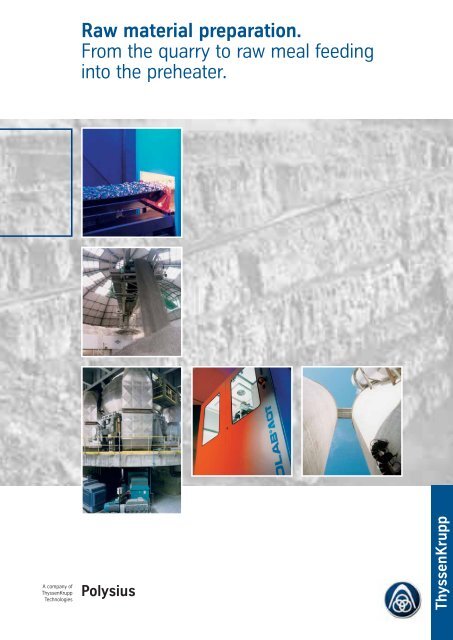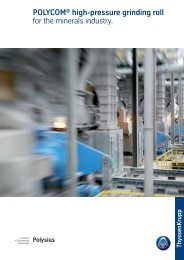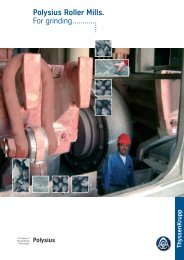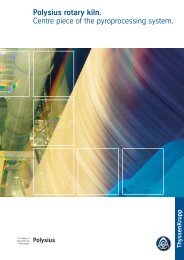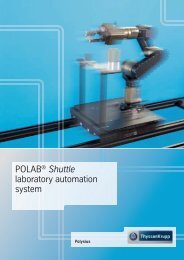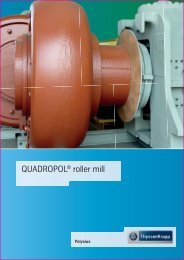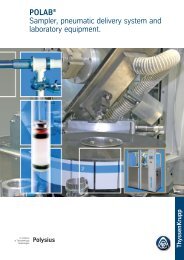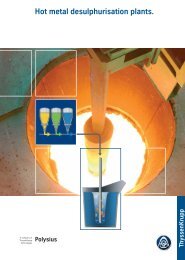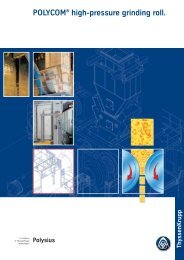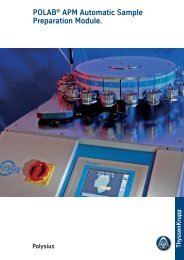Raw material preparation. From the quarry to raw meal feeding into ...
Raw material preparation. From the quarry to raw meal feeding into ...
Raw material preparation. From the quarry to raw meal feeding into ...
You also want an ePaper? Increase the reach of your titles
YUMPU automatically turns print PDFs into web optimized ePapers that Google loves.
<strong>Raw</strong> <strong>material</strong> <strong>preparation</strong>.<strong>From</strong> <strong>the</strong> <strong>quarry</strong> <strong>to</strong> <strong>raw</strong> <strong>meal</strong> <strong>feeding</strong>in<strong>to</strong> <strong>the</strong> preheater.A company ofThyssenKruppTechnologiesPolysiustk
2Future-oriented <strong>raw</strong> <strong>material</strong> <strong>preparation</strong> solutionsmade by Polysius:Innovative – Individual – Ideal.The manufacturing of cement begins with<strong>the</strong> extraction and <strong>preparation</strong> of <strong>raw</strong> <strong>material</strong>– a process covering <strong>the</strong> stages from <strong>raw</strong><strong>material</strong> <strong>quarry</strong>ing <strong>to</strong> <strong>feeding</strong> <strong>the</strong> <strong>raw</strong> <strong>meal</strong>in<strong>to</strong> <strong>the</strong> preheater.The purpose of optimum <strong>raw</strong><strong>material</strong> <strong>preparation</strong> for <strong>the</strong>cement manufacturing processis <strong>to</strong> supply <strong>the</strong> downstreamburning process with a <strong>raw</strong><strong>meal</strong> whose quality and homogeneityassures <strong>the</strong> economicalproduction of high-qualitycements. This can only beachieved if <strong>the</strong> plant designershave precise knowledge of <strong>the</strong><strong>material</strong>s that will be used (<strong>raw</strong><strong>material</strong>s and fuels). This is<strong>the</strong> basis for purposive selectionof <strong>the</strong> production process,including <strong>the</strong> blending, s<strong>to</strong>rage,homogenisation, grinding andanalysis systems.Taking in<strong>to</strong> account <strong>the</strong> determined<strong>material</strong> properties and<strong>the</strong> cus<strong>to</strong>mer-specific boundaryconditions, <strong>the</strong> requiredmachines and analysis equipmentis <strong>the</strong>n selected, dimensionedand arranged. To obtainsufficient latitude for <strong>the</strong> creationof alternative design solutions,Polysius uses ISAR.This database-linked softwareprogram allows <strong>the</strong> very fastsimulation of different plantand process configurations ona PC, including <strong>the</strong> resultingdevelopment of <strong>raw</strong> <strong>material</strong>homogeneity. This ensuresthat <strong>the</strong> optimum processtechnologicaland economicsolution is found for everyindividual project.As <strong>the</strong> first step, experiencedgeologists determine <strong>the</strong> available<strong>raw</strong> <strong>material</strong> deposits.Next, <strong>the</strong> chemical, mineralogicaland physical labora<strong>to</strong>ries of<strong>the</strong> Polysius Research Centreanalyse, evaluate and test <strong>the</strong><strong>raw</strong> <strong>material</strong> samples. Thanks<strong>to</strong> <strong>the</strong> very extensive Polysiusdatabase, <strong>the</strong> <strong>material</strong>s arereliably classified even if a relativelysmall amount of data isavailable.Whe<strong>the</strong>r a given depositis a suitable supplier of<strong>raw</strong> <strong>material</strong>s for <strong>the</strong>cement production processis decided on <strong>the</strong> basis ofprecise examination andanalysis data. As a firststep, geologists prospect<strong>the</strong> deposit.
3<strong>From</strong> <strong>the</strong> PC <strong>to</strong> reality:because of <strong>the</strong> diversity of<strong>raw</strong> <strong>material</strong> deposits, simplystringing standard individualprocesses or even just machinesone after <strong>the</strong> o<strong>the</strong>r is not enough.The desired success can only beachieved if a comprehensive view istaken, including <strong>the</strong> obtained <strong>raw</strong><strong>material</strong> data and <strong>the</strong> necessaryinvestment and operating costs.ISAR – a <strong>to</strong>tally unique softwareprogram – allows quick creationand simulation of an optimum <strong>raw</strong><strong>material</strong> <strong>preparation</strong> concept.Starting <strong>material</strong>OutputShear Test evaluation for moist <strong>material</strong>s – Polysius AG/Research and Development –1 2 3 4 5Client Singfa Singfa Singfa Singfa SingfaMaterial Clays<strong>to</strong>ne Clays<strong>to</strong>ne Clays<strong>to</strong>ne Clays<strong>to</strong>ne Clays<strong>to</strong>neWE-No. 10415 10415 10415 10415 10415Test-No. 0415C05 0415C10 0415C15 0415C16 0415C175Moisture content 5.0 10.0 15.0 16.0 17.5Normal stress g/cm 2 200 200 200 200 200Greatest consolidation stress g/cm 2 502 508 489 482 455Bulk <strong>material</strong> strength g/cm 2 92 184 262 271 227Effective angle of friction Degree 39 42 45 46 43Bulk <strong>material</strong> cohesion g/cm 2 24.5 52.1 80.8 86.3 71.7Flow functionffcffc < 1Hardenedffc < 2 Very cohesive 1.9 1.8Non-flowing2 < ffc < 4 Cohesive 2.8 2.04 < ffc < 10 Easy flowing 5.510 < ffc Free flowingAngle of wall friction St-37 Degree 27.0 24.5Angle of wall friction PVC Degree 23.9 19.8Angle of wall frictionDegreeHandling behaviour 0.21 1.73 5.65 6.60 4.05After <strong>the</strong> <strong>material</strong>-specific <strong>preparation</strong> of <strong>the</strong> representative<strong>material</strong> samples supplied by <strong>the</strong> geologists, labora<strong>to</strong>rytests determine <strong>the</strong> chemical and physical properties whichform <strong>the</strong> basis for evaluation and classification of <strong>the</strong><strong>raw</strong> <strong>material</strong>s.Handling –characteristic fac<strong>to</strong>r642WE-10415 Clays<strong>to</strong>ne10 15 20Moisture content [%]– Handling property depending on <strong>the</strong> moisture content –The determined<strong>material</strong> properties are<strong>the</strong> basis for <strong>the</strong>plant configuration.
4The process chainat a glance.x Crushing: crushers break up <strong>the</strong> <strong>raw</strong> <strong>material</strong> delivered from <strong>the</strong> <strong>quarry</strong> andprovide <strong>the</strong> <strong>raw</strong> mill with <strong>the</strong> feed size range it requires.Crushersx <strong>Raw</strong> <strong>material</strong> analysis: <strong>the</strong> POLAB ® CNA online analyser provides <strong>the</strong> firstdata regarding <strong>the</strong> chemical contents and/or homogeneity of <strong>the</strong> <strong>raw</strong> <strong>material</strong>.POLAB ® CNAx Bulk <strong>material</strong> s<strong>to</strong>rage/blending/metered <strong>feeding</strong>: <strong>the</strong> <strong>raw</strong> <strong>material</strong>s arebuffer s<strong>to</strong>red in s<strong>to</strong>ckpiles or homogenised in blending beds and <strong>the</strong>n supplied<strong>to</strong> <strong>the</strong> grinding process in <strong>the</strong> required flow rate and composition ei<strong>the</strong>r directlyor via feed bins.Longitudinal s<strong>to</strong>ckpile/longitudinal blending bedCircular s<strong>to</strong>ckpile/circular blending bedFlow regulation binx Grinding/drying: <strong>the</strong> <strong>raw</strong> <strong>material</strong> is ground in <strong>the</strong> <strong>raw</strong> mill <strong>to</strong> <strong>the</strong> finenessrequired by <strong>the</strong> downstream clinker burning process and dried.QUADROPOL ® roller millDOROL ® roller millAir-swept tube millPOLYCOM ® high-pressure grinding rollx <strong>Raw</strong> <strong>meal</strong> analysis: <strong>the</strong> <strong>raw</strong> <strong>meal</strong> samples are analysed at short intervals and<strong>the</strong> analysis data are used as <strong>the</strong> basis for controlling <strong>the</strong> <strong>raw</strong> <strong>material</strong> compositionand mill <strong>feeding</strong>.POLAB ® AOTPOLAB ® AMTx Final <strong>raw</strong> <strong>meal</strong> homogenisation/s<strong>to</strong>rage: <strong>the</strong> <strong>raw</strong> <strong>meal</strong> is homogenised ands<strong>to</strong>red in silos and <strong>the</strong>n supplied at a regulated flow rate <strong>to</strong> <strong>the</strong> preheater.Multi-cell siloTangential blending siloFilter dust handlingDosing and conveying systemsEverything starts with <strong>the</strong><strong>raw</strong> <strong>material</strong> <strong>quarry</strong>ing.Depending on its characteristics, <strong>the</strong> <strong>raw</strong><strong>material</strong> needed for <strong>the</strong> cement productionprocess is quarried by blasting, hydraulicexcava<strong>to</strong>rs or ripping. A wide range ofcrushing plants – depending on <strong>the</strong><strong>material</strong>’s properties and type of extraction– can be used for breaking <strong>the</strong> extracted<strong>raw</strong> <strong>material</strong> <strong>to</strong> <strong>the</strong> size required by <strong>the</strong><strong>raw</strong> mill. Polysius always installs crushersfrom renowned manufacturers.
High-performance analyser trio assures quality<strong>the</strong> vital fac<strong>to</strong>r.5While <strong>the</strong> <strong>raw</strong> <strong>material</strong>s andfuel grades are becoming moreand more complicated (primarilydue <strong>to</strong> <strong>the</strong> increasingly problematic<strong>raw</strong> <strong>material</strong> depositsand <strong>the</strong> use of secondary<strong>material</strong>s), <strong>the</strong> demands onclinker quality are increasing.This makes quality assurancewith highly effective analysissystems an absolutely indispensablecomponent of <strong>the</strong> <strong>raw</strong><strong>material</strong> <strong>preparation</strong> process.No generally valid concept canbe applied, but it is clear that<strong>the</strong> more complex <strong>the</strong> <strong>raw</strong><strong>material</strong>s and fuels <strong>the</strong> moredifficult it is <strong>to</strong> determine <strong>the</strong>right quality assurance conceptfor <strong>the</strong> particular applicationinvolved.With <strong>the</strong> POLAB ® CNA for onlineanalysis of <strong>the</strong> <strong>raw</strong> <strong>material</strong>upstream of <strong>the</strong> blending bed,POLAB ® AOT for online analysisof <strong>the</strong> <strong>raw</strong> <strong>meal</strong> downstreamof <strong>the</strong> <strong>raw</strong> <strong>material</strong> grindingsystem and POLAB ® AMT, <strong>the</strong>sample <strong>preparation</strong> and analysissystem in <strong>the</strong> central labora<strong>to</strong>ry,Polysius offers high-performancesystems that provideinformation about <strong>the</strong> chemicalcomposition and homogeneityof <strong>the</strong> <strong>material</strong>s at quality-relevantpoints of <strong>the</strong> process andinitiate appropriate control interventions.The systems areequipped with an adaptivemixture control which calculates<strong>the</strong> <strong>raw</strong> <strong>meal</strong> mixture inadvance and thus reliablymaintains <strong>the</strong> setpoint value.KST95,094,594,093,593,092,592,091,591,090,5Silo – current valueDownstream of millThe POLAB ® AOT <strong>raw</strong> <strong>meal</strong>analyser, whose footprint of only2.2 m (!) means that it can alsobe retrofitted without any problem,performs one control cycle every10 minutes; i.e. every 10 minutesa <strong>raw</strong> <strong>meal</strong> analysis is performedand <strong>the</strong> weighbelt setting of <strong>the</strong><strong>raw</strong> mill feed system is correctedby <strong>the</strong> adaptive mixture control.SetpointMeasurement time [2 days]Installed directly downstream of <strong>the</strong> <strong>raw</strong>mill, <strong>the</strong> POLAB ® AOT takes <strong>raw</strong> <strong>meal</strong>samples at short intervals, fine-grinds<strong>the</strong>m, analyses <strong>the</strong>m with its energy dispersiveX-ray fluorescence analyser andcontrols <strong>the</strong> <strong>raw</strong> <strong>material</strong> compositionand mill <strong>feeding</strong>.Use of <strong>the</strong> POLAB ® CNA analysis systemupstream of <strong>the</strong> blending bed ensures<strong>the</strong> earliest possible knowledge of <strong>the</strong>chemical content and homogeneity of <strong>the</strong><strong>raw</strong> <strong>material</strong>s. The entire flow of gravelsized<strong>raw</strong> <strong>material</strong> coming from <strong>the</strong> crusherpasses through <strong>the</strong> online analyser.POLAB ® AMT, <strong>the</strong> sample <strong>preparation</strong>and analysis system installed in <strong>the</strong>central labora<strong>to</strong>ry, performs all qualityassurance functions for a completecement production line.The POLAB ® CNA determines <strong>the</strong> process-relevant oxide concentrationsof <strong>the</strong> entire stream of <strong>material</strong> (no matter whe<strong>the</strong>r it isan individual component like limes<strong>to</strong>ne, marl or clay, or mixturesof <strong>the</strong>se) without requiring any pre-treatment. On <strong>the</strong> basis of<strong>the</strong> analysis results, <strong>the</strong> quality of <strong>the</strong> starting <strong>material</strong>s can becontrolled at an early stage, thus enabling optimum blendingbed stacking. Thanks <strong>to</strong> <strong>the</strong> modular design of <strong>the</strong> POLAB ® CNAit can be installed very quickly, even in<strong>to</strong> an existing conveyingsystem.
6The right mixture is crucial.Requirement-oriented blending and s<strong>to</strong>rage configurations.<strong>Raw</strong> <strong>material</strong> <strong>preparation</strong> with integrated blending bedThe <strong>raw</strong> <strong>material</strong> <strong>preparation</strong>concept with an integratedblending bed has establisheditself as <strong>the</strong> ideal solutionfor <strong>material</strong> components with»normal« and acceptable handlingproperties.The composition of <strong>the</strong> blendingbed is controlled by <strong>the</strong> onlineanalyser POLAB ® CNA, whichregulates <strong>the</strong> supply of differentcomponents <strong>to</strong> <strong>the</strong> crusher orbefore <strong>the</strong> blending bed and<strong>the</strong>reby keeps <strong>the</strong> chemicalvalues close <strong>to</strong> <strong>the</strong> setpoints.Upstream of <strong>the</strong> mill a precisionadjustment <strong>the</strong>n takes place on<strong>the</strong> basis of <strong>the</strong> <strong>raw</strong> <strong>meal</strong> analysisand <strong>the</strong> addition of correctivecomponents by <strong>the</strong> adaptivemixture control.The final homogenisation usuallytakes place in a tangentialblending silo.Limes<strong>to</strong>neClay<strong>Raw</strong> <strong>material</strong> <strong>preparation</strong> concept withintegrated blending bed – <strong>the</strong> ideal solutionfor <strong>material</strong> components with normaland acceptable handling properties.AdditivesFor efficient s<strong>to</strong>rageand homogenisation of<strong>the</strong> <strong>raw</strong> <strong>material</strong>s,Polysius offers a broadrange of blendingbed and s<strong>to</strong>rage technologyfor circular andlongitudinal installationswith harmonisedstacking and reclaimingmethods.
7<strong>Raw</strong> <strong>material</strong> <strong>preparation</strong>for <strong>material</strong>s with extremehandling propertiesMore and more often, <strong>the</strong> <strong>material</strong>sused have extreme handlingproperties (e.g. are verysticky or extremely moist), tend<strong>to</strong> segregate or are simply notsimultaneously available.In <strong>the</strong>se cases <strong>the</strong> individualcomponents have <strong>to</strong> be speciallys<strong>to</strong>red and prehomogenised<strong>to</strong> suit <strong>the</strong>ir handling and homogeneityproperties. These componentsremain separate untiljust before <strong>the</strong>y are fed in<strong>to</strong> <strong>the</strong>grinding plant. Particularly in <strong>the</strong>case of <strong>material</strong>s that are difficult<strong>to</strong> handle, <strong>the</strong> best solutionis direct <strong>feeding</strong> from <strong>the</strong> s<strong>to</strong>ragefacility in<strong>to</strong> <strong>the</strong> mill.In <strong>the</strong> case of longitudinal s<strong>to</strong>ckpilesthat are stacked discontinuously,<strong>the</strong> direct <strong>feeding</strong> systemcan consist of a combinationof several reclaimers. Forcircular blending beds, speciallydesigned discharge systems aregenerally used. With a direct mill<strong>feeding</strong> system <strong>the</strong>re is no need<strong>to</strong> convey <strong>the</strong> critical <strong>material</strong>in<strong>to</strong> an additional feed bin,which eliminates <strong>the</strong> o<strong>the</strong>rwisenecessary investment cost for<strong>the</strong> feed bin and associateddischarge regulation system.A POLAB ® AOT online <strong>raw</strong> <strong>meal</strong>analyser performs <strong>the</strong> mixturecontrolling.An important precondition fordirect mill <strong>feeding</strong> from <strong>the</strong>blending bed is <strong>the</strong> assuranceof a uniform flow of <strong>material</strong>.For this reason, <strong>the</strong> centralchute of <strong>the</strong> circular blendingbed’s bridge scraper is usedas a small buffer bin, whichparticularly compensates shortwavedischarge fluctuations.The compact Polysius blendingbed design, in which <strong>the</strong> chainof <strong>the</strong> bridge scraper passesthrough <strong>the</strong> central column,ensures that <strong>the</strong> <strong>material</strong> fallsin<strong>to</strong> <strong>the</strong> centre of <strong>the</strong> chute anddoes not adhere <strong>to</strong> its walls.The filling level of <strong>the</strong> centralchute is captured with a fillinglevel measuring device. If <strong>the</strong>filling level falls, <strong>the</strong> travel speedof <strong>the</strong> bridge scraper is au<strong>to</strong>maticallyincreased, which raises<strong>the</strong> reclaiming capacity.The direct mill <strong>feeding</strong> systemcan also be used if <strong>the</strong> circularblending bed is located at agreat distance from <strong>the</strong> mill.<strong>Raw</strong> <strong>material</strong><strong>preparation</strong> for<strong>material</strong>s thatare extremelydifficult <strong>to</strong>handle.Limes<strong>to</strong>neClayFeed bins for flow-regulated <strong>feeding</strong> of<strong>the</strong> <strong>raw</strong> grinding plant cannot always beavoided. Even if a direct mill <strong>feeding</strong> systemfrom <strong>the</strong> blending bed is installed,additives may have <strong>to</strong> be metered in<strong>to</strong> <strong>the</strong>stream of <strong>material</strong>. These feed bins have<strong>to</strong> be correctly dimensioned <strong>to</strong> provide <strong>the</strong>required buffer size and <strong>material</strong> flow andhandling characteristics. Only <strong>the</strong>n is properoutflow and metering of <strong>the</strong> <strong>material</strong>components permanently assured. Thanks<strong>to</strong> <strong>material</strong> investigation and classification,as well as <strong>the</strong> performance of shear testsif necessary, Polysius also offers reliablefeed bin solutions.Principle of adirect mill<strong>feeding</strong> system.ClayAdditives
8<strong>Raw</strong> <strong>material</strong> grinding plants.The requirements determine <strong>the</strong> mill type.Polysius offers a comprehensiverange of grinding processes.However, <strong>the</strong> right choiceof grinding plant for <strong>the</strong> respectiveapplication is governed bynumerous criteria.Apart from <strong>the</strong> <strong>raw</strong> <strong>material</strong>properties and <strong>the</strong> requiredthroughput capacity, <strong>the</strong> capitalinvestment, operating costsand availability are particularlyimportant fac<strong>to</strong>rs.The tube mill is a proven, simpleand easy <strong>to</strong> maintain machine,which also involves <strong>the</strong> lowestcapital cost.Its main disadvantages aresignificantly higher energy consumptioncompared <strong>to</strong> o<strong>the</strong>rgrinding processes and low<strong>material</strong> drying capability.The POLYCOM ®high-pressuregrinding roll has<strong>the</strong> lowest energyrequirement and can be readilycombined with o<strong>the</strong>r grindingprocesses, <strong>to</strong> achieve greatincreases in output. However,<strong>the</strong> POLYCOM ® also has a limited<strong>material</strong> drying capability.In about 85 percent of all <strong>raw</strong><strong>material</strong> grinding applications<strong>the</strong> roller mill is nowadays used.It offers <strong>the</strong> advantage of combiningthree work operations –grinding, drying and separating– in one compact unit. Thedesign of <strong>the</strong> DOROL ® doublerollermill, well-known fromover 250 installations all around<strong>the</strong> world, has been advanced.The result is <strong>the</strong> QUADROPOL ® ,which offers high throughputrates, low construction size andhigh availability. The QUADRO-POL ® has four grinding rollers,whose bearings are located outside<strong>the</strong> mill and are thus protectedagainst dust and hightemperature. The mill can beau<strong>to</strong>matically switched overfrom 4 <strong>to</strong> 2 roller operation,which provides great flexibilityand <strong>the</strong> ability <strong>to</strong> adapt <strong>to</strong>changes in <strong>raw</strong> <strong>meal</strong> requirement.For maintenance purposes,each pair of oppositegrinding rollers can be pivotedout of <strong>the</strong> mill housing. Thetwo roller units remaining in<strong>the</strong> mill <strong>the</strong>n take over <strong>the</strong> comminutionprocess, which is aprecondition for online operationwith an uninterrupted flow of<strong>material</strong> from <strong>the</strong> mill in<strong>to</strong> <strong>the</strong>kiln.Good accessibility, easy maintenance and<strong>the</strong> possibility <strong>to</strong> change over <strong>to</strong> partialloadoperation with 2 roller units withoutinterrupting operation complete <strong>the</strong> convincingQUADROPOL ® concept.
9The POLYCOM ® can be used as a primarymill, or in combination with, for instance,tube mills or as an au<strong>to</strong>nomous finishingmill. The more grinding work is shifted <strong>to</strong><strong>the</strong> high-pressure grinding roll, <strong>the</strong> higheris <strong>the</strong> energy saving compared <strong>to</strong> o<strong>the</strong>rsystems.The DOROL ® double-roller mill is <strong>the</strong>standard roller mill for grinding a verybroad range of <strong>material</strong>s including coal,blast furnace slag and clinker. This milltype has been constantly refined andoptimised over <strong>the</strong> years, and has thusachieved an excellent level of efficiencyand reliability.Simple plant concept andlow capital costs are characteristicfor <strong>the</strong> air-swept tube mill.
10Silo systems from Polysiusfor an uncompromising final homogenisation.In <strong>the</strong> case of <strong>raw</strong> <strong>meal</strong> silos, <strong>the</strong> trend <strong>to</strong>wardsmore complex <strong>raw</strong> <strong>material</strong>s demanded anincrease in <strong>the</strong>ir homogenisation capabilitiesand range of functions. Investment constraintsalso affected <strong>the</strong> requirement profile by forcinga reduction in silo size.The <strong>raw</strong> <strong>meal</strong> silo performs two functions: on<strong>the</strong> one hand it acts as a <strong>raw</strong> <strong>meal</strong> s<strong>to</strong>re, ensuringthat <strong>the</strong> kiln is supplied with <strong>raw</strong> <strong>meal</strong> evenduring <strong>raw</strong> mill s<strong>to</strong>ppages. On <strong>the</strong> o<strong>the</strong>r hand,it has <strong>the</strong> task of homogenising <strong>the</strong> <strong>raw</strong> <strong>meal</strong>produced by <strong>the</strong> <strong>raw</strong> mill <strong>to</strong> an extent whichensures that <strong>the</strong> kiln can produce a consistentlyhigh clinker quality. The silo has <strong>to</strong> maintain <strong>the</strong>degree of homogeneity achieved in <strong>the</strong> precedingprocess sections or <strong>to</strong> raise it <strong>to</strong> <strong>the</strong> targethomogeneity, if this has not yet been reached.<strong>the</strong> principle of homogenisation is <strong>the</strong> s<strong>to</strong>rageof horizontal layers which each have differentquality characteristics, followed by <strong>the</strong> verticalblending of <strong>the</strong>se layers when discharging <strong>the</strong>silo.Having thoroughly reengineered <strong>the</strong> standardblending silo, Polysius offers <strong>the</strong> tangentialblending silo and <strong>the</strong> multi-cell silo as solutionsfor <strong>the</strong> new requirements.The combination of <strong>the</strong> new systems‚POLAB ® AOT analyser and tangential blendingsilo, is one of <strong>the</strong> most innovative <strong>raw</strong> <strong>meal</strong>homogenisation and s<strong>to</strong>rage configurationson <strong>the</strong> market.Tangential blending siloThe tangential blending siloconsists of <strong>the</strong> silo shell, <strong>the</strong>distributing system, <strong>the</strong> innercone, <strong>the</strong> aeration surface with<strong>the</strong> discharge systems, <strong>the</strong>central mixing chamber, <strong>the</strong>aeration system and <strong>the</strong> dustcollection filter.The <strong>raw</strong> <strong>meal</strong> is fed in<strong>to</strong> <strong>the</strong>silo through <strong>the</strong> distributingsystem. Compared <strong>to</strong> <strong>the</strong> conventionalblending silo, <strong>the</strong>number of <strong>feeding</strong> arms hasbeen increased and a centralin<strong>feeding</strong> point has beeninstalled. As <strong>the</strong> <strong>feeding</strong> armsare alternately activated by acontrol system, it is not possiblefor <strong>the</strong> coarser grain sizefraction of <strong>the</strong> <strong>raw</strong> <strong>meal</strong> <strong>to</strong> permanentlyfall straight downon<strong>to</strong> <strong>the</strong> same point and forma pile of large-sized <strong>material</strong>.The special silo filling processthus already counteracts segregationof <strong>the</strong> <strong>raw</strong> <strong>meal</strong>.The new tangential blendingsilo has a unique aeration floorwhich covers almost<strong>the</strong> entire ring areaat <strong>the</strong> bot<strong>to</strong>m of <strong>the</strong>silo and thusensures optimumaeration of <strong>the</strong> <strong>raw</strong> <strong>meal</strong>. The<strong>material</strong> can be fluidised andextracted at all points of <strong>the</strong>silo floor. The aeration floor isof modular and compactdesign and can <strong>the</strong>refore besimply, efficiently and thuscost-effectively installed.The main process technologicaladvantage of this type of silo isderived from <strong>the</strong> new mode ofoperation of <strong>the</strong> central mixingchamber with constant fillinglevel. Due <strong>to</strong> <strong>the</strong> silo floor beingcompletely covered with aerationpanels with a large numberof outlets, it is possible <strong>to</strong>generate discharge funnels thatgo through <strong>the</strong> entire chargeof <strong>raw</strong> <strong>meal</strong>, even if it is nonfreelyflowing or o<strong>the</strong>rwiseproblematic. The discharge andfilling times for <strong>the</strong> <strong>material</strong> in<strong>the</strong> mixing chamber that iswithd<strong>raw</strong>n from one segmen<strong>to</strong>f <strong>the</strong> silo can be individuallyadapted <strong>to</strong> <strong>the</strong> size of <strong>the</strong> siloand mixing chamber, as well as<strong>the</strong> properties of <strong>the</strong> <strong>material</strong>.The constant filling level in<strong>the</strong> mixingchamber alsoresults in aconstant dischargebehaviour,whichensures that<strong>the</strong> downstreamflowregulatingunits receivean optimumfeed flow of<strong>material</strong>.Silo aerationfloor.Blending and dischargebehaviour in <strong>the</strong> tangentialblending silo.
11Multi-cell siloThe multi-cell silo, which isa combination of small silos,is particularly used in caseswhere <strong>the</strong> <strong>raw</strong> <strong>meal</strong> has astrong tendency <strong>to</strong> segregate(in response <strong>to</strong> <strong>the</strong> trend<strong>to</strong>wards complex <strong>raw</strong> <strong>material</strong>s)and/or in processes demanding<strong>the</strong> homogenisation of smalls<strong>to</strong>rage volumes (in response<strong>to</strong> <strong>the</strong> requirement for smaller<strong>raw</strong> <strong>meal</strong> silo capacities).The small individual membersilos of <strong>the</strong> multi-cell silo arefilled one after <strong>the</strong> o<strong>the</strong>r butdischarged simultaneously.The product is <strong>the</strong>n fed directly<strong>to</strong> <strong>the</strong> preheater. In this way,a reliable blending effect isachieved. The silos are sodesigned that mass flow isensured and no segregationcan occur.An important difference <strong>to</strong><strong>the</strong> already known multicompartmentsilo systemsis that <strong>the</strong> simultaneouslydischarged <strong>material</strong> isdirectly fed <strong>to</strong> <strong>the</strong> preheaterand not first keptin s<strong>to</strong>rage silos (whereexperience shows thatsegregation can againtake place).The advantages of <strong>the</strong> multi-cell silo at a glance:Cone and outlet of<strong>the</strong> multi-cell silo.x A defined minimum blendingeffect is ensured, even in <strong>the</strong>case of very complex <strong>raw</strong><strong>material</strong>s.x The size of <strong>the</strong> individualsilos ensures a constantmass flow.x For maintenance purposesone silo can be taken out of<strong>the</strong> combination and inspectedwithout affecting or evens<strong>to</strong>pping <strong>the</strong> system operation.x Any <strong>raw</strong> <strong>meal</strong> <strong>to</strong>nnages thatdiffer greatly in quality (firstcut of a blending bed, filterdust in mill bypass operation)can be filled in<strong>to</strong> one siloand subsequently slowly proportionedin<strong>to</strong> <strong>the</strong> main flow.x If <strong>the</strong> capacity of <strong>the</strong> completeplant is increased, <strong>the</strong><strong>raw</strong> <strong>meal</strong> capacity can beeasily and cost-effectivelyraised by adding on fur<strong>the</strong>rsmall silos.The individual cells of <strong>the</strong>multi-cell silo are filledone after <strong>the</strong> o<strong>the</strong>r butemptied simultaneously.


